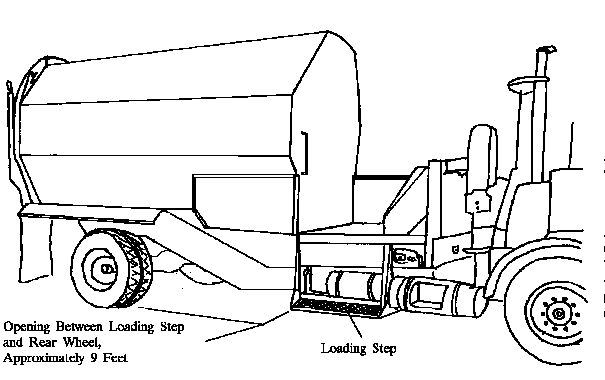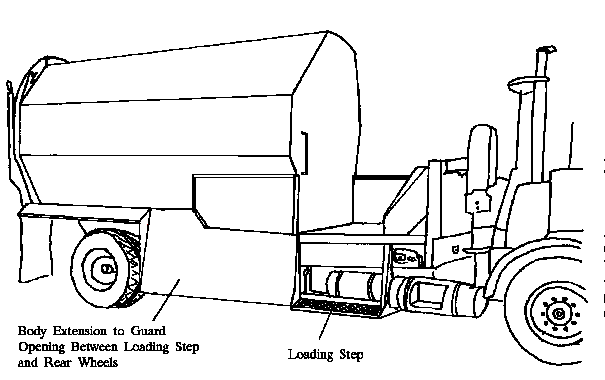Sanitation Worker Runover After Falling From Trash Collection Vehicle--Virginia
FACE 9411
SUMMARY
On February 14, 1994, a 41-year-old male municipal sanitation worker (the victim) died from head injuries he received when he was run over by the trash collection vehicle he had been riding on. The victim and a co-worker (driver) had been assigned curb-side pickups in a residential section of the city. They had just completed a pickup and the victim had mounted the right side loading step of the side-loader collection vehicle. The co-worker had boarded the right side driver’s station and was driving the vehicle to the next pickup, a distance of about 40 feet when, unknown to him, the victim slipped off the loading step and landed on the pavement, in the path of the right rear wheel. The vehicle ran over the victim’s head. The incident was witnessed by a homeowner who called out to the driver to stop. The driver stopped and an off-duty EMT who lived across the street from the pickup site came to render assistance to the victim while the homeowner called 911. The EMS responded and the victim was pronounced dead at the scene.
NIOSH investigators concluded that to prevent similar occurrences, employers should:
- develop and strictly enforce policies prohibiting trash collectors from riding on loading steps of trash collection vehicles
- consider equipping vehicles with safety devices designed to warn the driver when riders have left the steps of trash collection vehicles
- consider equipping vehicles with extended fenders or additional body panels to eliminate or reduce the likelihood of workers landing in the path of the vehicle’s wheels in the event of a fall.
INTRODUCTION
On February 14, 1994, a 41-year-old male sanitation worker (the victim) died when the trash collection vehicle he had been riding on ran over him. On April 12, 1994, officials of the Virginia Occupational Safety and Health Administration (VAOSHA) notified the Division of Safety Research (DSR) of the incident, and requested technical assistance. On May 5, 1994, a safety engineer from DSR met with the city risk management director and conducted an on-site investigation. The investigator reviewed the incident with the risk management director, the city safety inspector, and the VAOSHA compliance officer assigned to the case. The incident site was photographed and measurements of the trash collection vehicle were taken.
The employer in this incident is a municipality employing 2500, 13 of whom are sanitation workers. The city has a written safety policy. The city maintains a full time safety inspector for the solid waste department, who reports directly to the solid waste department director. Regular safety meetings are held. The victim had worked for the city for 23 years as a sanitation worker and although usually assigned to work on rear loading trash collection vehicles, he had worked on other types, including side-loading vehicles.
INVESTIGATION
On the day of the incident, the victim was assigned to accompany a co-worker (driver) on curbside pickups using a side-loading trash collection vehicle. This type of vehicle is normally operated by one worker who drives and also loads each pickup; however, on this day, the victim had arrived about 1 hour after the shift started, and the vehicle was late in going out on the route due to maintenance requirements. The victim and co-worker had left the municipal garage about 8:30 a.m. and were making curbside pickups in a residential area of the city that had paved streets but no sidewalks or built-up curbs. The weather was dry and sunny. Just before 11:30 a.m. the workers had completed about 100 pickups and the truck was half full. At that time, the victim made a pickup off the right side of the street and the driver made a pickup on the left side. The victim stepped up on to the right-side loading step and the driver boarded the right-side driver’s station. The truck is equipped with both left and right operating controls. The remainder of the pickups on the street were all on the right side. The driver looked in the rear view mirrors to ascertain that the victim was securely on the step and then drove to the next pickup, about 40 feet away. As the vehicle moved to the next pickup, the homeowner of the previous pickup observed the victim slip from the riding step and fall to the pavement. As he fell, he landed on the pavement with his head in front of the vehicle’s right rear wheel. The homeowner yelled a warning to the driver who applied the brakes, but the vehicle struck and ran over the victim’s head before the driver could stop. Another resident, an off-duty EMT, who lived across the street from the pickup, heard the warning and responded to give aid to the victim, while the homeowner notified 911. The victim was pronounced dead at the scene by responding EMS personnel.
CAUSE OF DEATH
The medical examiner determined the cause of death as head trauma.
RECOMMENDATIONSDISCUSSION
Recommendation #1: Employers should develop and strictly enforce policies prohibiting trash collectors from riding on the loading steps of trash collection vehicles.
Discussion: The normal pickup procedure for the side-loading truck being used in this incident was to be operated by a single worker who drove the vehicle and made the pickups. However, on the day of the incident, the victim arrived late for work and was assigned to work on the side-loading truck with another worker. This work assignment was made since all rear-loading trucks had left for their assigned routes. The workers were encouraged to ride the cabs of the vehicles but this was not a policy. Since this incident occurred, the city has adopted a policy prohibiting workers from riding the steps of side-loading trucks.
Recommendation #2: Employers should consider equipping vehicles with safety devices designed to warn the driver when riders have left the riding steps of trash collection vehicles.
Discussion: Devices are available which could be adapted to the riding steps of a trash-collection vehicle. Pressure-sensitive mats could be applied to the steps and would sense the presence or absence of a rider. The mats could be used to activate a warning light or buzzer located in the driver’s cab. Although the driver in this incident applied the vehicle’s brakes after the homeowner yelled a warning, an electronically operated warning could speed available response time, allowing the driver to stop more quickly.
Recommendation #3: Employers should consider equipping vehicles with extended fenders or additional body panels to eliminate or reduce the likelihood of workers landing in the path of the vehicle’s wheels in the event of a fall.
Discussion: An open space of approximately 9 feet existed between the loading step and the rear wheels of the vehicle, (Figure 1). This space between the wheels and the step was devoid of body work or fenders. Consideration should be given to covering this space with an extension of the truck body (Figure 2). Extended fenders or additional body panels would not prohibit a fall from the step, but could be installed in such a way that anyone falling off of the step would be deflected from the path of the wheels.

Figure 1. Configuration of Truck at Time of Incident

Figure 2. Possible Configuration of Extended Body
